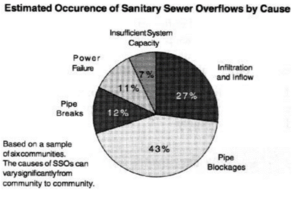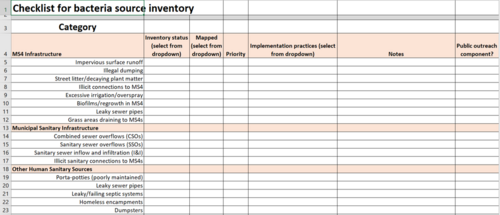
Support document for Checklist for bacteria source inventory Revision as of 16:08, 16 November 2020 by Mtrojan (talk | contribs) (→Municipal Sanitary Infrastructure - Sanitary sewer overflows (SSOs))
Page in development
The MPCA, working with stakeholders, developed a checklist for conducting an inventory of bacteria sources. The checklist is not a permit requirement but may be used to meet permit requirements. This page provides guidance and supporting information for the checklist.
Contents
- 1 Link
- 2 Structure of the checklist
- 3 Supporting information
- 3.1 MS4 Infrastructure - Impervious surface runoff
- 3.2 MS4 Infrastructure - Illegal dumping
- 3.3 MS4 Infrastructure - Street litter/decaying plant matter
- 3.4 MS4 Infrastructure - Illicit connections to MS4
- 3.5 MS4 Infrastructure - Excessive irrigation/overspray
- 3.6 MS4 Infrastructure - Biofilms/regrowth in MS4
- 3.7 MS4 Infrastructure - Leaky sewer pipes
- 3.8 MS4 Infrastructure - Grass areas draining to MS4s
- 3.9 Municipal Sanitary Infrastructure - Combined sewer overflows (CSOs)
- 3.10 Municipal Sanitary Infrastructure - Sanitary sewer overflows (SSOs)
- 3.11 Municipal Sanitary Infrastructure - Sanitary sewer inflow and infiltration (I&I)
- 3.12 Municipal Sanitary Infrastructure - Illicit sanitary connections to MS4s
- 3.13 Other Human Sanitary Sources - Porta-potties (poorly maintained)
- 3.14 Other Human Sanitary Sources - Leaky sewer pipes
- 3.15 Other Human Sanitary Sources - Leaky/failing septic systems
- 3.16 Other Human Sanitary Sources - Homeless encampments
- 3.17 Other Human Sanitary Sources - Dumpsters
- 3.18 Other Human Sanitary Sources - Trash cans
- 3.19 Other Human Sanitary Sources - Garbage trucks
- 3.20 Domestic pets - Dog parks
- 3.21 Domestic pets - Dogs, cats, etc. residential
- 3.22 Urban wildlife - Rodents/vectors
- 3.23 Urban wildlife - Birds/bird congregation areas (gulls, geese, pigeons)
- 3.24 Urban wildlife - Open space
- 3.25 Other urban sources - Landfills
- 3.26 Other urban sources - Food processing facilities
- 3.27 Other urban sources - Outdoor dining
- 3.28 Other urban sources - Restaurant grease bins
- 3.29 Other urban sources - Bars/stairwells (washdown areas)
- 3.30 Other urban sources - Road construction
- 3.31 Other urban sources - Piers/docks
- 3.32 Urban non-stormwater discharges - Power washing
- 3.33 Urban non-stormwater discharges - Car washing
- 3.34 Urban non-stormwater discharges - Pools/hot tubs
- 3.35 Urban non-stormwater discharges - Reclaimed water/gray water
- 3.36 Recreational sources - Bathers/boaters
- 3.37 Recreational sources - RVs (mobile)
- 3.38 Agricultural sources - Livestock/manure storage
- 3.39 Agricultural sources - Livestock, pasture
- 3.40 Agricultural sources - Livestock, corrals
- 3.41 Agricultural sources - Livestock (CAFOs)
- 3.42 Agricultural sources - Manure spreading
- 3.43 Agricultural sources - Municipal biosolids reuse
- 3.44 Agricultural sources - Reclaimed water/gray water
- 3.45 Agricultural sources - Irrigation tailwater
- 3.46 Agricultural sources - Slaughterhouses
- 3.47 Other sources - Grazing
- 3.48 Other sources - Streambank erosion
- 3.49 Other sources - Wildlife populations
- 3.50 Other sources - Other (describe in notes)
- 4 Related pages
Link
Link to the checklist: File:Checklist for bacteria source inventory.xlsx
Structure of the checklist
The checklist contains four worhsheets.
- Information
- Checklist
- Useful links
- Dropdowns
These are discussed below.
Information worksheet
This sheet provides basic general information about the checklist.
Checklist
This is the sheet where users enter information. Column A contains different categories of bacteria sources and specific sources within each category. The categories include the following.
- MS4 infrastructure
- Municipal sanitary infrastructure
- Other human sanitary sources
- Domestic pets
- Urban wildlife
- Other urban sources
- Urban non-stormwater discharges
- Recreational sources
- Agricultural sources
- Other sources
Columns B through G are where users input information.
- Column B: Inventory status. The user chooses from a dropdown list containing the following options - Completed, On-going, Planned this permit cycle, Not planned for this permit cycle, Not applicable. Completed means the practice has been fully implemented. On-going means the practice is being implemented but is not fully implemented. The two options pertaining to permit cycle only apply to MS4 permittees.
- Column C: Mapped. The user chooses from a dropdown list containing the following options - Yes, No, Partly. If a user has mapped or partially mapped the practice, consider describing the type of mapping in the Notes section (e.g. GIS).
- Column D: Priority. The user chooses from a dropdown list containing the following options - low, medium, high. The user indicates if the activity is a low, medium, or high priority.
- Column E: Implementation practices. The user can select a specific practice from a dropdown list or enter a user-specified value. The options are Water quality monitoring, Installation of pet waste bags, Elimination of over-spray irrigation, Street sweeping, Infiltration BMPs, Waterfowl management, Other, and NA (not applicable).
- Column F: Notes. The user can provide additional information in this column.
- Column G: Public outreach component. The user selects from a dropdown list with the options Yes or No. This applies to MS4 permittees who are attempting to meet Minimum Control Measures 1 or 2.
Supporting information
This section provides some basic information about each of the potential sources included in the checklist. Where appropriate we include links where additional information can be found.
MS4 Infrastructure - Impervious surface runoff
MS4 Infrastructure - Illegal dumping
MS4 Infrastructure - Street litter/decaying plant matter
MS4 Infrastructure - Illicit connections to MS4
MS4 Infrastructure - Excessive irrigation/overspray
MS4 Infrastructure - Biofilms/regrowth in MS4
MS4 Infrastructure - Leaky sewer pipes
MS4 Infrastructure - Grass areas draining to MS4s
Municipal Sanitary Infrastructure - Combined sewer overflows (CSOs)
Combined sewer systems (CSS) are sewers that are designed to collect rainwater runoff, domestic sewage, and industrial wastewater in the same pipe. During wet weather conditions, the volume of stormwater runoff can exceed the capacity of the CSS infrastructure, including both the piping system and/or the treatment plant. This is common where where older CSS infrastructure is in place, combining sanitary and storm drain flows. When the capacity of the CSS is exceeded, excess water can bypass treatment and bypassed flow will be mixed with the treated water prior to disinfection and just prior to discharge to the receiving water. While both stormwater runoff and sanitary sewer discharges contain bacteria, concentrations are much higher in untreated sewage. Thus, CSOs can lead to very high concentrations of bacteria in water delivered to receiving waters. For more information, see [2], [3], [4], [5], [6].
Municipal Sanitary Infrastructure - Sanitary sewer overflows (SSOs)

Sanitary sewer systems collect and transport domestic, commercial, and industrial wastewater. Some sanitary sewer systems may contain limited amounts of stormwater and infiltrated ground water to treatment facilities, but they are designed to carry just sewage and industrial wastewater. Occasionally, sanitary sewers will release raw sewage. These types of releases are called sanitary sewer overflows (SSOs). Possible causes of SSOs include blockages, line breaks, sewer defects that allow stormwater and groundwater to overload the system, power failures, improper sewer design, and vandalism. The adjacent image indicates line blockages appear to be an important cause of SSOs.
SSOs that discharge to surface waters are considered point source discharges and are thus prohibited unless authorized by a NPDES permit. SSOs may be indicative of improper operation and maintenance of the sewer systems, and may violate NPDES permit conditions. Effective illicit discharge and elimination practices and programs minimize the occurrence and impacts from SSOs.
For more information, see [7], [8],
